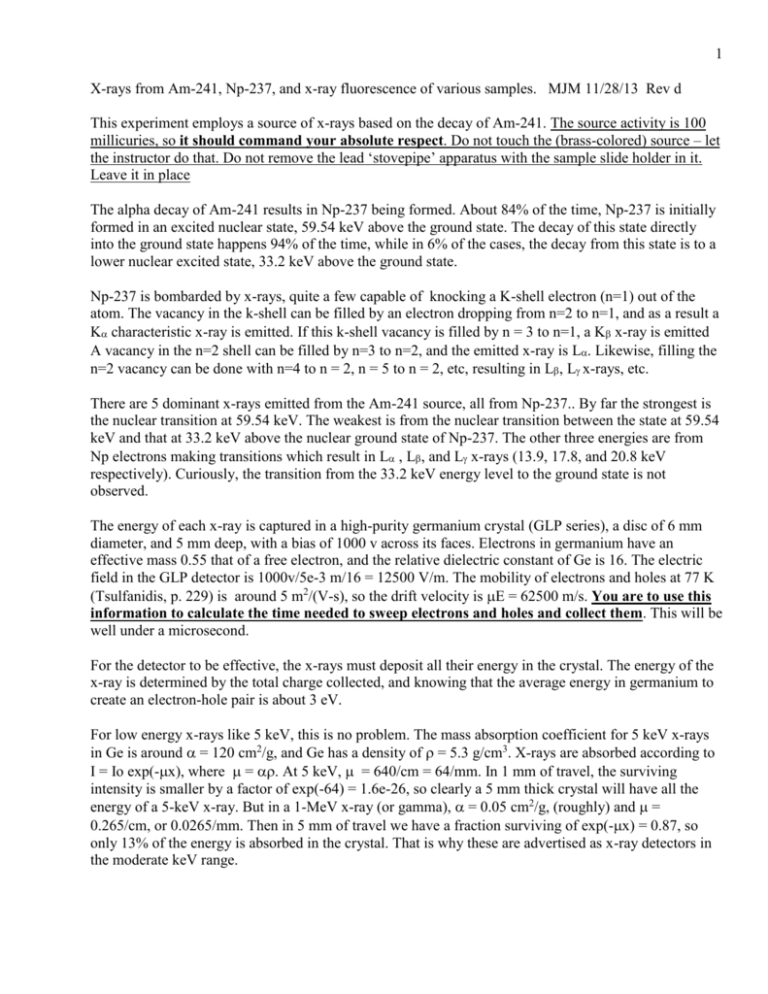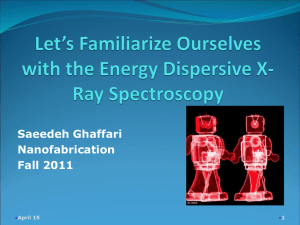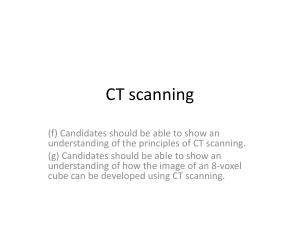X-rays from Am-241, Np-237, and x-ray fluorescence - Rose
advertisement

1 X-rays from Am-241, Np-237, and x-ray fluorescence of various samples. MJM 11/28/13 Rev d This experiment employs a source of x-rays based on the decay of Am-241. The source activity is 100 millicuries, so it should command your absolute respect. Do not touch the (brass-colored) source – let the instructor do that. Do not remove the lead ‘stovepipe’ apparatus with the sample slide holder in it. Leave it in place The alpha decay of Am-241 results in Np-237 being formed. About 84% of the time, Np-237 is initially formed in an excited nuclear state, 59.54 keV above the ground state. The decay of this state directly into the ground state happens 94% of the time, while in 6% of the cases, the decay from this state is to a lower nuclear excited state, 33.2 keV above the ground state. Np-237 is bombarded by x-rays, quite a few capable of knocking a K-shell electron (n=1) out of the atom. The vacancy in the k-shell can be filled by an electron dropping from n=2 to n=1, and as a result a K characteristic x-ray is emitted. If this k-shell vacancy is filled by n = 3 to n=1, a K x-ray is emitted A vacancy in the n=2 shell can be filled by n=3 to n=2, and the emitted x-ray is L. Likewise, filling the n=2 vacancy can be done with n=4 to n = 2, n = 5 to n = 2, etc, resulting in L, L x-rays, etc. There are 5 dominant x-rays emitted from the Am-241 source, all from Np-237.. By far the strongest is the nuclear transition at 59.54 keV. The weakest is from the nuclear transition between the state at 59.54 keV and that at 33.2 keV above the nuclear ground state of Np-237. The other three energies are from Np electrons making transitions which result in L , L, and L x-rays (13.9, 17.8, and 20.8 keV respectively). Curiously, the transition from the 33.2 keV energy level to the ground state is not observed. The energy of each x-ray is captured in a high-purity germanium crystal (GLP series), a disc of 6 mm diameter, and 5 mm deep, with a bias of 1000 v across its faces. Electrons in germanium have an effective mass 0.55 that of a free electron, and the relative dielectric constant of Ge is 16. The electric field in the GLP detector is 1000v/5e-3 m/16 = 12500 V/m. The mobility of electrons and holes at 77 K (Tsulfanidis, p. 229) is around 5 m2/(V-s), so the drift velocity is E = 62500 m/s. You are to use this information to calculate the time needed to sweep electrons and holes and collect them. This will be well under a microsecond. For the detector to be effective, the x-rays must deposit all their energy in the crystal. The energy of the x-ray is determined by the total charge collected, and knowing that the average energy in germanium to create an electron-hole pair is about 3 eV. For low energy x-rays like 5 keV, this is no problem. The mass absorption coefficient for 5 keV x-rays in Ge is around = 120 cm2/g, and Ge has a density of = 5.3 g/cm3. X-rays are absorbed according to I = Io exp(-x), where = . At 5 keV, = 640/cm = 64/mm. In 1 mm of travel, the surviving intensity is smaller by a factor of exp(-64) = 1.6e-26, so clearly a 5 mm thick crystal will have all the energy of a 5-keV x-ray. But in a 1-MeV x-ray (or gamma), = 0.05 cm2/g, (roughly) and = 0.265/cm, or 0.0265/mm. Then in 5 mm of travel we have a fraction surviving of exp(-x) = 0.87, so only 13% of the energy is absorbed in the crystal. That is why these are advertised as x-ray detectors in the moderate keV range. 2 ‘Escape peaks’ It is occasionally possible for an entering x-ray 1) to eject a K-shell electron from Ge and then 2) to have the K or K xray escape from the detector. This has to happen close to the surface of the detector. When an x-ray escapes like this, the detector captures all the energy of the original x-ray except for the energy of the ‘escaped’ x-ray. The energies of germanium K and K xrays are 9.88 keV and 10.98 keV respectively. Fairly often, one can observe an ‘escape peak’ below a strong peak in the spectrum. Silver, for example, has a K peak at 22.1 keV. A strong silver K peak may very well show a smaller escape peak at (22.1 – 9.88) keV, and maybe a weaker one at (22.1 – 10.98) keV Photoelectric collisions. In germanium, the dominant way low-keV x-rays interact is the photoelectric effect. A 15-keV x-ray having a photoelectric collision with a germanium atom would disappear and an electron would be ejected as a result. If the x-ray had a 15-keV energy and ejected an electron from the germanium K-shell, the x-ray would vanish, there would be some recoil of the atom, and an electron would emerge with approximately 5 keV of kinetic energy. This electron would go crashing around and create lots of electron-hole pairs (EHPs). Since it takes about 3 eV to create an EHP in germanium, some 1700 EHPs would be created from this electron. Compton Collisions. Compton-effect collisions also occur in significant numbers. In this type of collision, the x-ray is scattered and keeps on going, having lost some energy from the collision. Usually an electron in the atom is struck and goes flying off, ionizing the atom. The photon loses significant energy in such a collision (often called a ‘soft’ compton collision). Sometimes the photon collides with the atom, and the entire atom recoils, not just one electron. In this type of collision (a ‘hard’ collision) the x-ray loses almost no energy, coming away from the collision with its energy almost unchanged.. Software and hardware The source activity is 100 millicuries, so it should command your absolute respect. Do not touch the (brass-colored) source – let the instructor do that. Do not remove the lead ‘stovepipe’ apparatus with the sample slide holder in it. Leave it in place The detector must be cold (LN2 temperature) before any bias voltage is applied. It takes the detector overnight to cool properly, so one must always wait till the day after the dewar has been filled with LN2 before applying a bias voltage. There must always be liquid nitrogen in the dewar. The dewar sits on a large scale which should be attached to a powered display giving the weight. Roger sets the scale to zero before filling, and after filling, the reading is that of the liquid nitrogen, before the large lead attachment and slide are put on. With the attachment on, the scale will read approximately 12 lbs more than it did with LN2 only. Check each time to see that the scale shows more than 12 lbs, to be sure there is still LN2 inside. The output channel from the detector is OUTPUT 2. This is connected via a coaxial cable and BNC connector to the input of the MCA card. The software for the MCA is ‘ICS-PCI’ on the cart computer. When you enter the software, do not set the voltage to 900v. There is a high voltage connection on the back of the MCA card, but we will not use this. Instead, the detector will be powered by -1000 v from the SRC high voltage power supply. (The detector also must have its ‘D’ connector inserted into the back of the Ortec 452 spectroscopy amplifier, and power to the amplifier must be turned on.) 3 The ICS PCI software have its ‘mode’ set to ‘PHA Amp In’. The coarse gain should be set to 32, the fine gain to 1.0. The LLD (lower level discriminator) should be set to 2.5. The output of the MCA (multichannel analyzer) gives counts vs channel number. In order to know what channel number (02047) corresponds to what x-ray energy, you must create a ‘calibration curve’. This is to be done using some of the known elements. Copper, for example, has a K energy of 8.04 keV, so you do a run with copper as the sample and find the channel number of the huge peak for K. Your first run should be 15 minutes (900 sec), Coarse gain = 32, fine gain = 1 with just the large annular copper target. You will find a big peak in the lower channels, and a distinct peak around channel 1450, as well as a number of other peaks. The peak near channel 1400 is from the 59.6-keV x-rays which have undergone ‘hard’ collisions in the target, so still have basically their original energy. This run gives you two points for your calibration curve. (The huge peak around channel 1200 is from the 59.6-keV x-rays which have had ‘soft’ compton collisions in the target.) You should always save each run to a file on the PC, giving it an identifying title. Two versions should be saved. One should be *.tsv, and the other *.ssf. The *.tsv file can be opened and read by Excel, and also by (don’t laugh) Notepad. The *.ssf file can be read by the MCA software (ICS-PCI). This will let you reopen the file in the MCA software if you need to. (Notepad turns out to be surprisingly convenient for scrolling through the data.) . Later, save all your data to a flash drive. In Excel, you can change the vertical scale by clicking on the vertical axis (say, on top of ‘25000’) then going to ‘Format Axis’ and putting in the new vertical scale max and min. Ditto for the horizontal scale. 4 Please create a calibration curve with 6 points. For this you will need 4 more known elements, preferably spaced between 8 and 60 keV. There are 8 ‘coin’ sources - disc-shaped, labeled elements (Ti, Ta, Zn, Zr, Ag, Mo, Se, Dy), and a few others. For the characteristic energies of K and L lines of the elements, you can use the web. Each run should be the same specs as for copper; 15 min, CG 32 FG 1. (In Excel, I got messed up a couple of times with the channel number and the number of the column. If I did an ‘Insert’ in column A, this moved everything over one column, and it was easier to get the correct channel number.) Get Excel to fit the ‘curve’ with a linear trendline, and get the equation on the graph. Don’t settle for less than 4 sig figs in the trendline equation. Make sure it is a very good straight line, point fitting closely to the curve. Use the calibration curve to predict the channel numbers of the ‘hard’ peaks from Np (4 of them in addition to the one you already have at 59.6 keV). Then look for these peaks in your run for copper. You should find a peak for each quite close to the predicted channel. Make a table of predicted and observed peak channels. Now do two runs to determine the size of the ‘Escape’ peaks. The original peak should be large and fairly well defined, and the ‘escape’ peak will be about 9.9 keV lower in energy, and quite a bit smaller. Silver (discussed earlier) is a good candidate. An element which is a good candidate will have both the main peak and the ‘escape’ peak are not in regions with a lot of other counts.. Your job is to find the ratio of total counts in the ‘escape’ peak to the counts in the main peak for two different elements. Express your result as a percent of the counts in the main peak. Be sure to clearly explain how you determined the total counts in each peak. Identify one peak with energy greater than 59.6 keV, find its energy and match it to a ‘line’ from an element (could be Pb, Au, …) Select one ‘unknown’ and identify at least two elements in it. 5 Essentials to be included in your report Calibration curve and its equation, including underlying data. Two escape peaks, giving counts in the escape peak as a percent of those in the main peak. Find at least one peak above the 59.6 keV peak (above channel 1450), and identify it based on some heavy element (gold, lead, ...) Show that the predicted and observed energies agree closely. The peaks up there are not very big so you will have to look with some care. You will need to look up the K energies of x-rays above 60 keV. Google for something like Characteristic X-Ray energies. Calculate how long it will take to sweep out a ‘pulse’ of EHPs from the detector. One unknown, identifying at least two elements. ======================================= Please make it clear what you are doing in various places in the report. One report per person. Sidebars. You may find it handy to find NIST x-ray mass attenuation coefficients Detector capture parameters. To be an x-ray detector, it must capture ‘all’ of the x-ray energy. This detector is 5 mm thick and at 5 keV the x-ray absorption cross section in Ge is = 258 cm2/g. The density of Ge is = 5.3 g/cm3, so the absorption coefficient is = = 1368/cm. In 1 mm the surviving intensity is I = Io exp(-x) = Io exp(-137) = Io * 3 x 10-60. That captures all at 5 keV in 1 mm thickness of detector . At 25 keV we find and = 22.1 cm2/g, and I = Io * 5.7 x 10-15. So 1 mm captures all 25 keV photons. At 100 keV = 1 cm2/g, and for all 5 mm, I = Io * 0.071; 7% get through without being detected. Source to target. The source is 100 mCi, so its decay rate is 3.7 x 10 9 /s. There are 5 x-rays of interest, so the x-ray rate is 1.85 x 1010/s. The target can be taken as a disc of radius 3 cm, at a distance r = 5 cm from the source, oriented at 40o angle to r. The solid angle is = A cos /r2, or = (32) cos 40o/52 = 0.78 Sr. Dividing by 4, gives about 7% of the source x-rays reaching the target. Target to detector. From the target to the detector is a distance of perhaps 30 cm, so the solid angle subtended by the detector at the target is = A cos /r2 = (32) cos 0o)/302) = 0.03. Dividing by 4 ogives 0.0025 as the fraction of xrays leaving the target and reaching the detector. Of the 1.85e10 x-rays leaving the source, a maximum of 3.2 x 106 per second reach the detector. That is one every 0.3 microseconds arriving at the detector on the average. The K energy from Np is about 125 keV, so this will not be seen in this experiment because it is too high in energy, and there are very very few energies available in the Np decay which are this high. You can go online to get a decay scheme for Np to check this out. ‘Escape peak’ probability. If a K from Ge were 1 mm from the edge of the detector and headed straight for the edge, what would be its chances of evading capture and escaping? For Ge we have at 9.6 keV, = 42.3 cm2/g, and = = 224/cm. Then I = Io exp(-22.4) = Io 2 e-10 so that effectively none of these would escape. At a distance of 0.1 mm, 10% of them would escape. Of the ones going at 0.1 mm and making a 30o angle to the direct path would have a 7.5% chance of escape. A path at 60o to the direct one would give a 1% chance of escape. I get 10% of the volume to be within 0.1 mm of the surface. From there the overall escape likelihood is much less than 10%. This suggests the escape peak coun ts should be 1% or less of the main peak counts. However, you will find that the escape counts run to several percent of the main counts.







